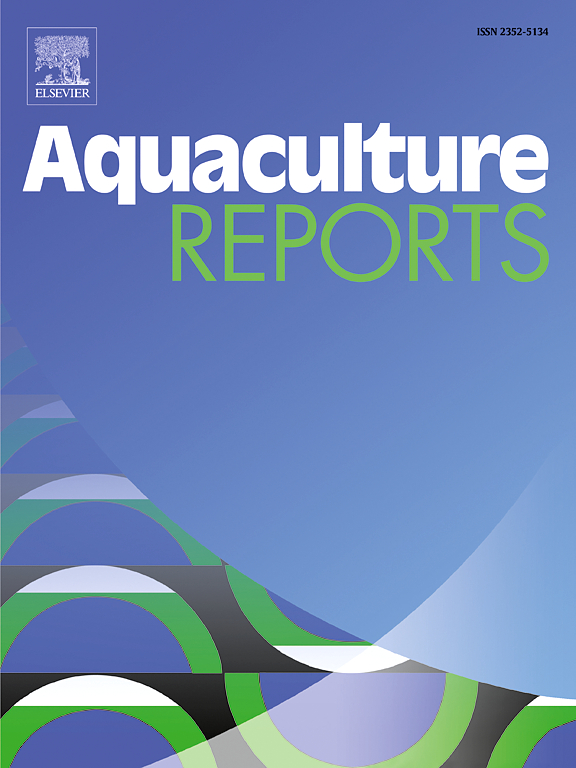Long-term effects of high carbohydrate feeding in Nile tilapia broodstock on intermediary and carbohydrate metabolism in offspring through juvenile stage
IF 3.2
2区 农林科学
Q1 FISHERIES
引用次数: 0
Abstract
Hyperglucidic stimulation involving high-carbohydrate (CHO) feeding in broodstock could be a practical tool for achieving nutritional programming (NP) in fish. Therefore, this study aimed to investigate the effects of high-CHO (HC) feeding stimuli on reproductive performance, and intermediary CHO metabolic responses in broodstock and its long-term impact on CHO and related metabolism in offspring. Two different CHO diets, HC/low-protein (LP) and low-CHO/high-protein (LC/HP), were fed to mature female and male Nile tilapia. The HC/LP diet in female broodstock led to decreased egg weight, but increased fecundity and gonadosomatic index compared with that with the LC/HP diet. In females and males, blood metabolites, hepatic and muscular compositions, and CHO and its related metabolic responses at the molecular level reflected HC feeding. Similar CHO intermediary metabolic responses were found in offspring at 7-days post-hatching and 7 days after the first feeding, suggesting that the parental effects of CHO intermediary metabolism could be transmitted to offspring at early developmental stages. Modulation of intermediary CHO metabolic responses persisted in the juvenile offspring, with increased hepatosomatic index and hepatic triglyceride levels, muscular glycolysis induction, and suppression of hepatic gluconeogenesis and amino acid catabolism. Juvenile offspring fed the HC diet also had more pronounced intermediary CHO metabolism, including glycogenesis, lipogenesis, glycolysis induction, muscular glucose transport, and suppression of hepatic gluconeogenesis and amino acid catabolism. Collectively, the HC diet-mediated hyperglucidic stimuli in broodstock induced NP effects in offspring, which persisted through the juvenile stage.
长期高碳水化合物饲喂对尼罗罗非鱼幼鱼中间产物和碳水化合物代谢的影响
高糖刺激与高碳水化合物(CHO)摄食可能是实现鱼类营养规划(NP)的实用工具。因此,本研究旨在探讨高CHO (high-CHO, HC)摄食刺激对亲鱼繁殖性能和中间CHO代谢反应的影响及其对后代CHO及相关代谢的长期影响。采用HC/低蛋白(LP)和低CHO/高蛋白(LC/HP)两种不同的CHO饲料饲喂成熟雌罗非鱼和雄罗非鱼。与LC/HP饲粮相比,HC/LP饲粮降低了雌性亲鱼的蛋重,但提高了繁殖力和促性腺指数。在雌性和雄性中,血液代谢物、肝脏和肌肉成分、CHO及其相关代谢反应在分子水平上反映了HC摄食。在孵化后第7天和第一次摄食后第7天,后代的CHO中间代谢反应相似,表明亲本CHO中间代谢的影响可以在发育早期传递给后代。中间CHO代谢反应的调节在幼代中持续存在,肝体指数和肝脏甘油三酯水平升高,肌肉糖酵解诱导,肝脏糖异生和氨基酸分解代谢受到抑制。饲喂HC饲料的幼崽也有更明显的中间CHO代谢,包括糖生成、脂肪生成、糖酵解诱导、肌肉葡萄糖运输以及肝脏糖异生和氨基酸分解代谢的抑制。总之,HC饮食介导的高糖刺激在亲鱼中诱导了后代的NP效应,这种效应持续到幼年期。
本文章由计算机程序翻译,如有差异,请以英文原文为准。
求助全文
约1分钟内获得全文
求助全文
来源期刊

Aquaculture Reports
Agricultural and Biological Sciences-Animal Science and Zoology
CiteScore
5.90
自引率
8.10%
发文量
469
审稿时长
77 days
期刊介绍:
Aquaculture Reports will publish original research papers and reviews documenting outstanding science with a regional context and focus, answering the need for high quality information on novel species, systems and regions in emerging areas of aquaculture research and development, such as integrated multi-trophic aquaculture, urban aquaculture, ornamental, unfed aquaculture, offshore aquaculture and others. Papers having industry research as priority and encompassing product development research or current industry practice are encouraged.
 求助内容:
求助内容: 应助结果提醒方式:
应助结果提醒方式:


